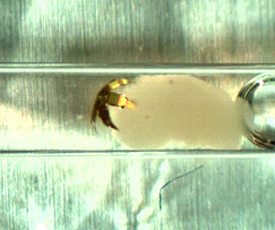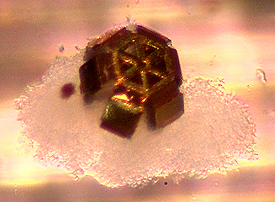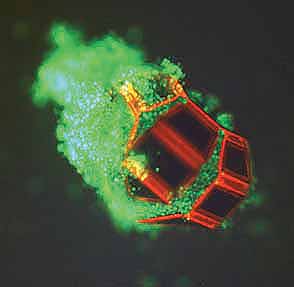The invention may be the first step on the way to tiny mobile robots, capable of performing microsurgery inside the body

Researchers at Johns Hopkins University have invented devices the size of a grain of dust, capable of capturing and removing living cells from hard-to-reach areas, without the need for electrical wires, test tubes or batteries. The invention may be the first step on the way to tiny mobile robots, capable of performing microsurgery inside the body.
As reported this week in the prestigious scientific journal, PNAS, the diameter of the robots does not exceed a tenth of a millimeter, but despite their tiny size, they can be produced in large quantities and at a relatively low price. The researchers tested the capabilities of the robots in the laboratory and showed that they are capable of performing a biopsy - removing a number of cells from living tissue - on living tissue placed inside a narrow tube.
At the current stage, the robots are only a first generation and a prototype, and are not intended for human treatments.
David H. Gracias, who oversaw the project, says that these microtools, which respond to heat and chemicals, represent a paradigm shift in engineering. "We've shown cheap, tiny tools that can undergo mass activation using non-toxic biochemicals," said Gracias, assistant professor of chemical and biomolecular engineering at the Whiting School of Engineering at Johns Hopkins University. "This is an important first step towards creating a new set of independent micro- and even nano-tools for surgery, which react biochemically, and can help doctors diagnose diseases and provide treatment in a more effective and less invasive way."

Today, doctors interested in collecting cells from the patient's body, or treating damaged tissue, often use micro-tweezers connected to thin wires or tubes, but these wires make it difficult to navigate the tool in certain areas of the body. To solve the problem, the free pins that Garcia's group has developed contain gold-plated nickel, which allows them to be attracted to magnets located outside the body.
"In this way, we were able to move the micro-tweezers from a distance, to a relatively large distance in the tissue without getting stuck," he says. "In addition, the microtweezers are tuned to close and pull the cells out of the tissue when exposed to certain biochemicals or biologically relevant temperatures."
The micro-pincers are designed like a tiny crab - six limbs with three joints, emerging from a central body (in fact, the inspiration for the design of the limbs came from the insects, the arthropods). The researchers used photolithography - a method also used to make computer chips - to design the micro-tweezers in an initial flat position, with all their legs completely straight. If and when the day comes, and the tiny devices are inserted into the body and driven by a magnet, it will be possible to locate and guide them using medical imaging units such as MRI or CT.
How do the microtweezers grab the cells in the tissue? This ability is based on the chemical composition of the joints of the limbs. The joints contain thin layers of chromium and copper, which exert forces that should cause the limbs to fold in on themselves, similar to the fingers of the hand. To prevent spontaneous closure of the prosthesis, the researchers added polymer resin, which gives the limb joints sufficient rigidity and prevents the limbs from closing.

When the micro-tweezers reach their destination, the researchers can raise the temperature to forty degrees Celsius (equivalent to a moderate-high fever in humans) to soften the polymer in the joints and allow the limbs to close. Another way to activate the limbs is by injecting non-toxic biological solutions, which are able to soften the polymer and cause the pincers to close on their target.
In laboratory experiments, the researchers were able to cause the micro-tweezers, guided by a magnet, to catch and transport a colored globule from a pool of colorless globules in an aqueous solution. The members of the group also captured dozens of living cells from a mass of cells placed at the end of a thin tube. The cells were still alive about 72 hours after the experiment, proving that the capture procedure did not harm them. The micro-tweezers were even able to grab samples of bovine bladder tissue, which is considered to be particularly strong tissue.
The experiments proved that the wire-free microrobot idea is indeed feasible, and has the potential for medical applications, but not everything is rosy. The robots will have to go through many more changes until an initial prototype is designed to perform surgical operations on humans. To activate the robot today, the body temperature must be raised, or bio-solutions must be injected into the bloodstream. This idea may be engineering acceptable, but it is likely that it will take time for it to be accepted by doctors and patients. In addition, the biggest problem facing the researchers will probably be finding a way to remove the robots - along with the cells they carry - from the patient's body after the medical procedure is performed.
Despite the many difficulties that still await microrobots, they may lead to far-reaching applications. It is not impossible that in the future micro-robots will be able to perform biopsies on individual cells, diagnose whether they are cancerous and release toxic substances that will be able to kill the tumor inside the body in a targeted manner. Other micro-robots, or even nano-robots, will be able to carry out operations of genetic engineering and even daily maintenance of the body. But in science there are no great leaps - there is only a series of small steps, which finally converge into a finished product. The Gracias microrobot is another small step on the way to the promising future of medicine.

7 תגובות
Interesting article, the future will focus on nanotechnology, that's clear.
Stunning!
Let's hope it will be successful and they will be able to help cancer patients.
Nice but not a robot.
Very interesting article. I have no doubt that the future of medicine and technology will focus on nanotechnology.
Hanan Sabat
http://WWW.EURA.ORG.IL
I wish we could see the progress in these areas more often. It brings a lot of hope to many terrible diseases
Looks like they put a Tasmanian devil in a test tube :)
It's crazy